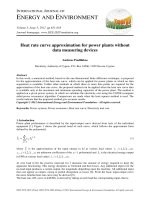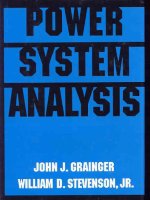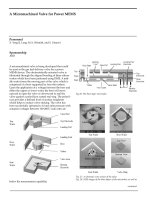Engineering Calculation for Power System Analysis
Bạn đang xem bản rút gọn của tài liệu. Xem và tải ngay bản đầy đủ của tài liệu tại đây (1.49 MB, 178 trang )
Engineering Calculation for Power
System Analysis
Page 1 of 178
CONTENTS
Modules
Pages
1. Load Flow Calculation.
3-16
2. Short Circuit Analysis.
17-47
Case1-ANSI/IEEE Method
Case2-IEC Method
3. Motor Starting Analysis.
48-66
4. Transient Stability Analysis.
67-96
Case1-Single Machine System
Case2-Multi Machine System
5. Relay Co-ordination.
97-107
6. Harmonic Analysis.
108-125
7. Ground Grid Analysis.
126-141
8. Optimal Capacitor Placement.
142-151
9. Arc Flash Analysis
152-164
10. Underground Raceway System
166-183
Page 2 of 178
1. LOAD FLOW ANALYSIS
Page 3 of 178
INTRODUCTION:
Load flow solution analysis is essential for designing a new power system and planning of
the existing one for increased load demand, which determine the steady state operating
condition to calculate,
Voltage Profile - its magnitude in kV or % of nominal kV
Current flow throughout the System
MVA and /or MW plus Mvar power flows throughout each branch of the (i.e.
transformer, cables, line or series reactor etc) electrical system
Voltage drop and Power factor
Branch Losses i.e. MW & Mvar losses on each branch
Page 4 of 178
Input data required for LFA:
Sl.no
Component
1
2
3
Bus
Power Grid
Syn Generator
4
Transformer
5
Motor
6
Syn Motor
7
Static Load
8
Lump Load
9
Cable
8
Transmission Line
9
10
MOV
Protective Devices
11
Capacitor
12
Impedance
Required input
Nominal kv
Voltage rating, MVA sc, X/R ratio
1. Swing (slack) – %v and del
2. Voltage Control (PV) – MW, Mvar limits
3. Mvar Control (PQ) -MW, Mvar and Var limits
4. PF Control-MW and PF
Py kV, Sec kV, MVA, %Z Positive sequence Impedance,
%Tap, Tolerance and LTC settings
1. Status- Continuous , Intermittent or Spare
2. Rating-HP and kV
1. Status- Continuous , Intermittent or Spare
2. Rating-HP and kV
1. Status- Continuous , Intermittent or Spare
2. Rating-kV, MW, Mvar and PF
1. Status- Continuous , Intermittent or Spare
2. Ratings- kV, MW, Mvar and PF
3. Load Type-Motor Load or Static load
1. Length in ft/m/mile/km
2. Cable Type- Size, Insulation, kV and #/Cable
3. Impedance/conductor-Positive sequence
1. Length in ft/m/mile/km
2. Parameter-Phase conductor
3. Impedance per phase-positive sequence
1.
Rating-HP, kV and rated Torque
2. Circuit Breakers-Rated kV
3. Fuses-Rated kV
4. Switches-Rated kV and amps
5. Contactors- Rated kV and amps
1) Status- Continuous , Intermittent or Spare
2) Rating-kV, Max kV, Mvar Bank and No of Banks.
1) Rating-Amps and kV
2) Impedance- Positive sequence Z and X/R
Page 5 of 178
STEP by STEP Procedure for Load Flow Analysis
Step 1: Build the Single Line Diagram
Page 6 of 178
Step 2: Input Parameters/data for LFA
Power Grid:Nominal kV
kAsc
X/R
= 11kV
= 40 kA
= 14
Assume it is the base kV=11
Cable:Cable sizes and types are selected from the software library
Insulation
= XLPE
kV
= 15
Conductor type= CU
#/Cable
= 3/c
Size
= 300mm2
Length
= 0.836 km
Transformer:Primary kV = 11
Secondary kV = 0.433
MVA
= 10
%Z and X/R = Typical Value
Z Tolerance = If %Z <10 tolerance is 10
%Z >10 tolerance is 7.5 ( thumb rule)
Tap
= If needed. (To improve the bus voltage)
Lump Load:MW
=4
Mvar
=3
%PF
= 80
Load Type
= 100% Motor Load & 0% Static Load
Step 3: Data needed for Hand Calculation
Power Grid:X/R
MVAsc
= 14
= 762.102
Cable:R
X
Transformer:Z%
X/R
= 0.0801 Ω/km
= 0.1273 Ω/km
= 6.75
= 15.5
Page 7 of 178
Step 4: ETAP WITH HAND CALCULATION
1. To find Voltage Drop(Vd)
Formula: %Voltage drop= Delta V*100 --------------------------------------- eq1
To find Delta V:
Delta V= (√ (Vr+ (RP+XQ/Vr) ^2+ (XP-RQ/Vr) ^2))-Vr ----------------------- eq2
Where:
Vr = Receiving end voltage
R = Resistance of the cable/transmission in p.u
P = Real Power in MW
Q = Reactive Power in Mvar
X = Reactance of the cable in p.u
S= Apparent power in p.u
We know that,
Base MVA
= 100 MVA
Base kV
= 11 kV
Nominal kV
= 11 kV
Load PF
= 0.8
R Ω/km
= 0.0801 Ω
X Ω/km
= 0.12736 Ω
Length
= 0.836 km
Assume Vr
= 1 p.u
To find Z base:
Zbase
= BasekV^2/Base MVA
= 11^2 / 100
Page 8 of 178
Z base = 1.21
R
= R*length / Zbase
= 0.0801*0.836 / 1.21
R = 0.0554
X
= X*length / Zbase
= 0.12726*0.836 / 1.21
X = 0.0879
To Find P, Q and S:
We know MW and Mvar of Lump load,
a. To find
MVA =√ (MW^2+Mvar^2)
= √ (4^2+3^2)
MVA=5.033
P
= MW/Base MVA
= 4 / 100
P=0.040
Q
= Mvar/Base MVA
= 3 / 100
Q=0.030
S
= MVA/Base MVA
=5.033 / 100
S=0.0503
The following tabular columns are the results in p.u:
R
0.055
X
0.088
P
0.040
Q
0.030
S
0.0503
Page 9 of 178
To find % voltage drop:
eq 2=>
Delta V= (√ (Vr+ (RP+XQ/Vr) ^2+ (XP-RQ/Vr) ^2))-Vr
Consider Vs=1 p.u
Assume Vr = 1 p.u
Substitute the above calculated values from the table in the eq2
Delta V= (√ (1+ (0.055*0.040+0.088*0.030/1) ^2+ (0.088*0.040-0.055*0.030) ^2))-1
Delta V = 0.005
Note Vs ≠Vr so we are finding the new Vr new
Vr new=Vr -Delta V-----------------------------------------------eq3
= 1- 0.005
Vr new=0.995
To find Voltage drop:
eq 1=>
Voltage drop= Delta V*100
= 0.005*100
Voltage drop (Vd) = 0.5
Page 10 of 178
2. To find cable loss:
Formula:
MW =R*S^2*Base MVA*(Base kV/Nominal kV) ^2------------------ eq 4
Mvar = X*S^2*Base MVA*(Base kV/Nominal kV) ^2------------------ eq 5
To find MW:
Eq 4=>
MW
=R*S^2*Base MVA*(Base kV/Nominal kV) ^2
=0.055*0.0503*0.0503*100*(0.433/ 0.433) ^2
MW = 0.014
To Find Mvar:
Eq 5=>
Mvar
= X*S^2*Base MVA*(Base kV/Nominal kV) ^2
=0.088*0.0503*0.0503*100*(0.433/ 0.433) ^2
Mvar = 0.022
Cable losses = MW+jMvar = 0.014+j0.022
Page 11 of 178
3. To find Transformer Losses
Formula:
MW =R*S^2*Base MVA*(Base kV/Nominal kV) ^2-------------------- eq 6
Mvar = X*S^2*Base MVA*(Base kV/Nominal kV) ^2-------------------- eq 7
We know that
Nominal kV
=11 kV
Source kA
=40 kA
X/R
=14
Base MVA
=100
Z%
= 6.75
X/R
= 15.5
To find transformer new %R, %X and %Z:
%R
=Z%* √ {(1/(X/R) ^2) +1}
=6.75*√ {1 / (15.5 ^2 +1)}
%R=0.43
%X
= √ {%Z^2 - %R^2}
=√ {6.75^2- 0.43^2}
%X=6.74
%Z
= √ {%R^2 + %X^2}
=√ {0.43^2 + 6.74^2}
%Z=6.75
To Find R, X, P, Q and S in p.u:
R
= %R / TFR MVA
Page 12 of 178
= 0.43/10
R=0.0434
X
= %X / TFR MVA
= 6.74/10
X=0.674
P
= PMW / Base MVA
= 4/100
P=0.04
Q
= Q Mvar / Base MVA
= 3/100
Q = 0.03
S
= √ (P^2+Q^2)
= √ (0.04^2+0.03^2)
S=0.05
The following tabular columns are the results in p.u:
R
0.0434
X
0.674
P
0.04
Q
0.03
S
0.05
Page 13 of 178
To find MW:
eq 6=>
MW
=R*S^2*Base MVA*(Base kV/Nominal kV) ^2
=0.0434*0.05*0.05*100*(11/11) ^2
MW = 0.011
To Find Mvar:
eq 7=>
Mvar
= X*S^2*Base MVA*(Base kV/Nominal kV) ^2
=0.674*0.05*0.05*100*(11/11) ^2
Mvar = 0.199
Transformer losses = MW+jMvar = 0.011+j0.199
Page 14 of 178
Step 5: Run Load Flow Analysis with ETAP software
Page 15 of 178
Step 6: Summary Report.
Step 7: Comparison Table.
Hand Calculation
MW
Mvar
ETAP Result
MW
Mvar
Cable Losses
0.014
0.022
0.015
0.02
Transformer Losses
0.011
0.199
0.012
0.188
Cable Voltage drop
0.5
0.5
Page 16 of 178
2. SHORT CIRCUIT ANALYSIS
(IEEE / ANSI AND IEC METHOD)
Page 17 of 178
CASE 1:-ANSI / IEEE METHOD
INTRODUCTION:
The ETAP Short-Circuit Analysis program analyzes the effect of 3-phase, line-to-ground,
line-to-line, and line-to-line-to-ground faults on electrical distribution systems. The program
calculates the total short circuit currents as well as the contributions of individual motors,
generators, and utility ties in the system. Fault duties are in compliance with the latest
editions of the ANSI/IEEE Standards (C37 series).
Purpose of Short-Circuit Studies:
A Short-Circuit Study can be used to determine any or all of the following:
Verify protective device close and latch capability
Verify protective device Interrupting capability
Protect equipment from large mechanical forces (maximum fault kA)
I2t protection for equipment (thermal stress)
Selecting ratings or settings for relay coordination
Elements that Contribute Current to a Short-Circuit:
Generator
Power Grid
Synchronous Motors
Induction Machines
Lumped Loads
(with some % motor load)
Inverters
I0 from Yg-Delta Connected Transformer
Elements that do Not Contribute Current in PowerStation:
Static Loads
Motor Operated Valves
Page 18 of 178
All Shunt Y Connected Branches
Short-Circuit Phenomenon:
Page 19 of 178
v(t)
i(t)
di
Vm Sin( t )
dt
equation 1 yields the following
v(t) Ri L
RL
-
i(t)
expression
e
Solving
(1)
t
Vm
Vm
sin( t - )
sin( - )
Z
Z
Steady
State
Transient
(DC Offset)
Copyright 2003 Operation Technology, Inc. – Workshop Notes: Short-Circuit ANSI
Slide 9
Symmetrical Faults:
The ETAP Short-Circuit Analysis program analyzes the effect of 3-phase
Symmetrical faults on electrical distribution systems. The program calculates the total short
circuit currents as well as the contributions of individual motors, generators, and utility ties in
the system. Fault duties are in compliance with the latest editions of the C37 series which
calculates
Momentary symmetrical fault current in kA
Interrupting symmetrical fault current in kA
Unsymmetrical Faults:
The ETAP Short-Circuit Analysis program also analyzes the effect of 3-phase
unsymmetrical Faults like
Line to Ground fault
Double line fault
Double line to ground fault.
Page 20 of 178
½ Cycle Network
This is the network used to calculate momentary short-circuit current and protective device
duties at the ½ cycle after the fault.
1 ½ to 4 Cycle Network
This network is used to calculate the interrupting short-circuits current and protective device
duties 1.5-4 cycles after the fault.
30-Cycle Network
This is the network used to calculate the steady-state short-circuit current and settings for
over current relays after 30 cycles of the fault.
Device Duty and Usage of Fault Currents from Different Networks:
HV Circuit Breaker
LV Circuit Breaker
Fuse
SWGR / MCC
Relay
½ Cycle Currents
(Sub transient Network)
Closing and Latching
Capability
Interrupting Capability
Interrupting Capability
Bus Bracing
Instantaneous Settings
1 ½ to 4 Cycle Currents
(Transient Network)
Interrupting
Capability
-
Page 21 of 178
ANSI Calculation Standard Compliance:
ETAP short circuit calculation per ANSI/IEEE Standards fully complies with the latest
ANSI/IEEE and UL Standards, as listed below:
Standard
EEE C37.04
Pub. Year
Title
1979(1988)
Standard Rating Structure for AC High-Voltage Circuit
IEEE C37.04f
1990
Breakers Rated on a Symmetrical Current Basis and
IEEE C37.04g
1986
Supplements
IEEE C37.04h
1990
IEEE C37.04i
1991
IEEE C37.04
1999
IEEE C37.010
1979, 1988,1999
IEEEC37.010b
1985
Circuit Breakers Rated on a Symmetrical Current Basis
IEEE C37.010e
1985
and Supplements
IEEE C37.010
1999
IEEE C37.13
1990
Standard Application Guide for AC High-Voltage
Standard for Low-Voltage AC Power Circuit Breakers
Used in Enclosures
IEEE C37.013
1997
Standard for AC High-Voltage Generator Circuit
Breakers Rated on a Symmetrical Current Basis
IEEE C37.20.1
1993 2002
Standard for Metal Enclosed Low-Voltage Power
Circuit Breaker Switchgear
IEEE Std 399
IEEE Std 141
1990 & 1997
1986, 1993, 2002
Power System Analysis – the Brown Book
Electric Power Distribution for Industrial Plants – the
Red Book
IEEE Std 242
1986 & 2001
IEEE Recommended Practice for Protection and
Coordination of Industrial and Commercial Power
Systems – the Buff Book
UL 489_9
1996, 2000, 2002
Standard for Safety for Molded-Case Circuit Breakers,
Molded-Case Switches, and Circuit-Breaker Enclosures
Page 22 of 178
Input data required for SCA:
Sl.no
1
2
3
Component
Bus
Power Grid
Syn Generator
4
Transformer
5
Motor
6
Syn Motor
7
Static Load
8
Lump Load
9
Cable
8
Transmission Line
9
10
MOV
Protective Devices
11
Capacitor
12
Impedance
Required input
Nominal kv
Voltage rating, MVA sc, X/R ratio
1. Swing – %v and del
2. Voltage Control – MW, Mvar limits
3. Mvar Control-MW, Mvar and Var limits
4. PF Control-MW and PF
5. Imp/Model-Impedance(Xd’’,Xd’, Xd, Xo, X2 and X/R)
1. Rating-Py kV, Sec kV, MVA
2. Impedance-%Z (+Ve & -Ve sequence Impedance)
3. Tolerance
4. Tap-Fixed Tap and LTC settings
5. Grounding-Py and Sec.
1. Status- Continuous , Intermittent or Spare
2. Rating-HP and kV and select MFR details.
3. Model-%LRC, %PF.
4. Model-Parameters-X0, X/R
1. Status- Continuous , Intermittent or Spare
2. Rating-HP and kV and select MFR details.
3. Model-Impedance(Xd’’,Xo,Xd’,X2, X/R)
1. Status- Continuous , Intermittent or Spare
2. Rating-kV, MW, Mvar and PF
1. Status- Continuous , Intermittent or Spare
2. Ratings- kV, MW, Mvar and PF
3. Load Type-Motor Load or Static load
1. Length in ft/m/mile/km
2. Cable Type- Size, Insulation, kV and #/Cable
3. Impedance/conductor-Positive sequence
1. Length in ft/m/mile/km
2. Parameter-Phase conductor
3. Impedance per phase-positive sequence
1. Rating-HP, kV and rated Torque
1. Circuit Breakers-Rated kV, Amps, Interrupting kA
2. Fuses-Rated kV, Size, Amps, Interrupting kA
3. Switches-Rated kV , BIL ratings and amps
4. Contactors- Rated kV, Interrupting kA and amps
1. Status- Continuous , Intermittent or Spare
2. Rating-kV, Max kV, Mvar Bank and No of Banks.
1. Rating-Amps and kV
2. Impedance- Positive sequence Z and X/R
Page 23 of 178
Step 1: Build the single line diagram using ANSI / IEEE method
Page 24 of 178
Step 2: Input Parameters/data for short circuit Analysis
Power Grid:Nominal kV
= 33 kV
MVAsc
= 750 kA
X/R
= 14
kAsc
= 13.12
Length
= 4.85km
R
= 0.1ohms/km
X
= 0.1ohms/km
Cable:-
Transformer:Primary kV
= 33 kV
Secondary kV = 6.3 kV
MVA
= 15 MVA
Base MVA
= 1 MVA
Z%
= 14.38
X/R
= 24.94
LRC
= 400%
Input MVA
= 5.676
LRC
= 550%
Input MVA
= 1.282
Motor 1:-
Motor 2:-
Page 25 of 178









